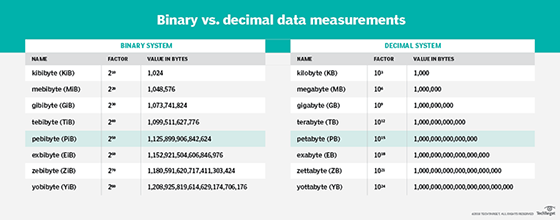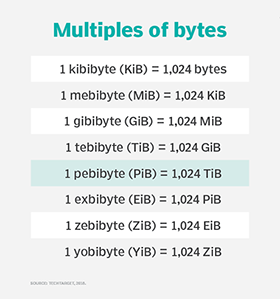pebibyte (PiB)
What is a pebibyte (PiB)?
A pebibyte (PiB) is a unit of measure that describes data capacity. The prefix pebi was created as part of the binary system for measuring computing and storage capacity, which is based on powers of two. One pebibyte equals 250 or 1,125,899,906,842,624 bytes.
The term pebibyte and the other binary prefixes -- kibi, mebi, gibi, tebi, exbi, zebi and yobi – were created by the International Electrotechnical Commission (IEC) in 1998. Prior to developing the binary prefixes, computing capacity was measured using the metric prefixes of the International System of Units (SI). These older SI prefixes -- including kilo, mega, giga, tera, peta, exa, zetta and yotta -- are also referred to as the decimal system of prefixes.
Before 1998, the SI prefixes were used to refer to both the power-of-10 multipliers in the decimal system of measurement and power-of-two multipliers used in the binary system. During the decades when the SI prefixes were used to refer to both the decimal and binary multiplier systems, context was the only way to determine which multiplier was being referred to when, say, the term petabyte (PB) was used. That term could refer to either 1015 (1,000,000,000,000,000) bytes or 250 (1,125,899,906,842,624) bytes.
Since the IEC created the binary prefixes in 1998, the system people use often depends on what discipline or industry they work in. The decimal system's power-of-10 metric prefixes are more likely to be used by people in communications, electronics and physics. The power-of-two binary prefixes are more likely to be used in the IT and data storage industries.
What pebibytes are used for
In the early days of computing, using the same prefixes to refer to both the power-of-10 and the power-of-two multipliers wasn't a significant problem. Because data storage capacity was much smaller than what it is today, the difference between the two systems was relatively small.
For instance, 1 kilobyte (KB) of data capacity equals 1,000 bytes using the power-of-10 system. Using the power-of-two system, 1 KB of data equals 1,024 bytes. The 24-byte difference between the two systems was small enough to be considered negligible. However, as computing and data capacity have grown over the years, the difference between the numbers generated by the two measurement systems has been magnified.
A petabyte of data using the power-of-10 decimal system equals 1,000,000,000,000,000 bytes, while a petabyte of data using the power-of-two binary system equals 1,125,899,906,842,624 bytes. That's a difference of more than 125 trillion bytes. At higher levels of capacity, the differences in the numbers generated by the two measurement systems began to cause problems and could no longer be ignored.
One problem was particularly bothersome to users of HDDs and SSDs. Disk drive manufacturers used the decimal system when they labeled the capacity of HDDs and SSDs. But OS vendors often used the binary system to report computer memory and data storage capacity. When a customer bought a new hard drive that the manufacturer labeled using the decimal system as having 100 gigabytes (GB) of capacity, the computer OS, using the binary system of measurement, would report that it had only 93.13 GB of capacity. Customers weren't happy to lose what looked like nearly 7 GB of capacity before they had even used the HDD.
The development of the prefixes associated with the IEC standard for the binary system of measurement was supposed to eliminate this type of confusion. In the example above, the OS would have used the binary system of prefixes instead of the decimal system, and would have reported 93.13 gibibytes (GiB) instead of 93.13 GB of capacity. The use of the new prefixes was supposed to let consumers know that the OS vendor was using a different system of measurement from the HDD manufacturer.

However, the new prefixes haven't been widely used, and the creation of the binary prefixes didn't solve the capacity measurement problem. The binary prefixes are mostly used by academics, technical writers and open system developers. Commercial vendors and IT professionals generally aren't using the binary prefixes.
How large is a pebibyte?
A pebibyte is at the larger end of the binary measurement scale. It's larger than the following binary data capacity measures:
- A kibibyte (KiB) -- a PiB is equal to 1,099,511,627,776 KiB.
- A mebibyte (MiB) -- a PiB is equal to 1,073,741,824 MiB.
- A gibibyte -- a PiB is equal to 1,048,576 GiB.
- A tebibyte (TiB) -- a PiB is equal to 1,024 TiB.
Binary data capacity measures that are larger than a pebibyte include an exbibyte (EiB), which is 1,024 times the size of a PiB. A zebibyte (ZiB) is 1,048,576 times the size of a PiB. And a yobibyte (YiB) is 1,073,741,824 times the size of a PiB.
Visualizing the size of a pebibyte
With the advent of big data and data analytics, an increasing number of organizations have data stores in the pebibyte range.
Here are some concrete ways to visualize pebibytes of data in the real world:
- A pebibyte can store more than a trillion pages of plain text type.
- 239,553 movies on standard, single-layer DVDs is equivalent to 1 PiB.
- All U.S. research libraries combined hold 1.78 PiB of data.
- A pebibyte of songs, averaging four minutes of playing time each, would last more than 2,250 years playing continuously.
Pebibyte vs. petabyte and tebibyte
A pebibyte is more than 12.5% larger than a petabyte. When assessing storage capacity, that's a significant difference.

When working with the lower capacity ranges, such as a kibibyte vs. a kilobyte or a mebibyte vs. a megabyte, the differences between binary and decimal units of measure is negligible. However, with pebibytes vs. petabytes, the difference between the two systems matters.
A pebibyte equals 1,024 TiB. To do the conversion, divide the 1,125,899,906,842,624 bytes that make up a pebibyte by the number of bytes in a tebibyte, or 1,099,511,627,776. That gives you 1,024 TiB.
Each consecutively higher prefix in the binary system of capacity measurement has 210, or 1,024, times the number of bytes of the next lower prefix. A pebibyte is 1,024 times larger than a tebibyte in terms of bytes. An exbibyte is 1,024 times larger than a pebibyte. And a zebibyte is 1,024 times larger than an exbibyte and so on.
Editor's note: This article was revised in 2023 by TechTarget editors to improve the reader experience.








